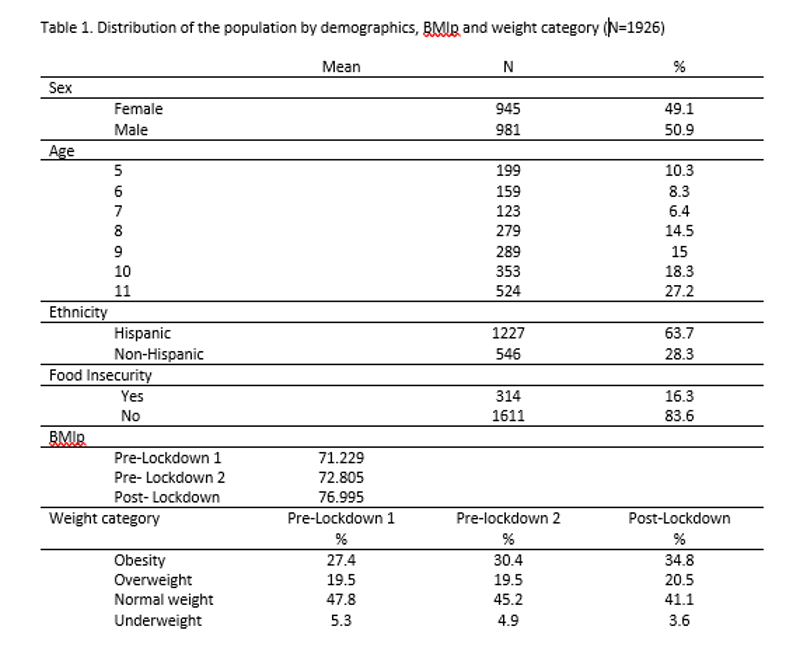Obesity
Category: Abstract Submission
Obesity II
518 - BMI changes in a pediatric population during the COVID-19 pandemic lock-down.
Saturday, April 23, 2022
3:30 PM - 6:00 PM US MT
Poster Number: 518
Publication Number: 518.239
Publication Number: 518.239
Isabella Vallenilla, Icahn School of Medicine at Mount Sinai-Elmhurst, Rego Prk, NY, United States; Andres Rivera, Icahn School of Medicine at Mount Sinai, New york, NY, United States; Shreeya Parajuli, Icahn School of Medicine at Mount Sinai, Elmhurst, NY, United States; Smrithi Krishnamohan, Icahn School of Medicine at Mount Sinai - Elmhurst, Queens, NY, United States; M. P. Gonzalez, Icahn School of Medicine at Mount Sinai, Forest Hills, NY, United States; Tina Cheng, Icahn School of Medicine at Mount Sinai, Elmhurst, NY, United States; Janet Siegel, Icahn School of Medicine at Mount Sinai/Elmhurst, Great Neck, NY, United States; Tania C. Lopez, Icahn School of Medicine at Mount Sinai, Queens, NY, United States; Larissa Polanco, Icahn School of Medicine at Mount Sinai, Bayside, NY, United States; Thaina Rousseau-Pierre, Mount Sinai School of Medicine, Elmhurst, NY, United States

Isabella Vallenilla, MD
Resident
Icahn School of Medicine at Mount Sinai-Elmhurst
Rego Prk, New York, United States
Presenting Author(s)
Background: The COVID-19 pandemic affected several known determinants in the development of obesity. Our group previously established that there were BMI changes during the lockdown period in an adolescent population but it was unclear if those changes were evident in school-aged children.
Objective: To evaluate the Body Mass Index Percentile (BMIp) of school-aged children 5-11 years old before and after the lockdown measures imposed with the COVID-19 pandemic. Furthermore, this study aims to determine if factors such as prior overweight/obesity, age, sex, and ethnicity were associated with these changes.
Design/Methods: We performed a cross-sectional retrospective review of patients seen in the Pediatric clinic of a community hospital in Queens, NY aged 5 to 11 years old, we recorded 1 to 2 measurements during the pre-lockdown to period(January-2018 to February-2020) and 1 during the post-lockdown period(June-2020 to February-2021). We obtained the data by an Epic report. We used the IBM SPSS Statistics for Windows version 25 to calculate mean BMIp and prevalence by category. We used paired sample t-test to compare Pre and Post BMIp for the population and according to demographics. We also analyzed the trend of the BMIp by repeated measures analysis.
Results: We studied 1888 children aged 5-11 years old. Mean BMIp went from 72.8 to 76.9. Obesity increased from 30.4% to 34.8%. There was a statistically significant difference in mean BMIp between pre and post-lock-down periods (t(1859)=11.329,p=0.0) with a mean difference of 4.0938 (95%CI[3.3851-4.8025]). BMIp increased in children with underweight and normal-weight and decreased in children with overweight and obesity. These trends were also observed on the repeated measurement analysis. All demographic categories had statistically significant BMI variance. Hispanics and people reporting food insecurity had higher BMIp but less variance. Conclusion(s): We observed an increase in the mean BMIp among the children in the study. This increase was at the expense of children with low weight and normal-weight at baseline. A decrease was observed in children with overweight and obesity. This pattern was also observed in a previous study by our group on adolescents. The differences observed among the groups suggest the profound changes lockdown measures entail and reinforce the diversity of mechanisms leading to overweight and obesity.
Isabella Vallenilla, MD CVCV 01-2022 Dr. Vallenilla.pdf
Distribution of the population by demographics, BMIp and weight category
Objective: To evaluate the Body Mass Index Percentile (BMIp) of school-aged children 5-11 years old before and after the lockdown measures imposed with the COVID-19 pandemic. Furthermore, this study aims to determine if factors such as prior overweight/obesity, age, sex, and ethnicity were associated with these changes.
Design/Methods: We performed a cross-sectional retrospective review of patients seen in the Pediatric clinic of a community hospital in Queens, NY aged 5 to 11 years old, we recorded 1 to 2 measurements during the pre-lockdown to period(January-2018 to February-2020) and 1 during the post-lockdown period(June-2020 to February-2021). We obtained the data by an Epic report. We used the IBM SPSS Statistics for Windows version 25 to calculate mean BMIp and prevalence by category. We used paired sample t-test to compare Pre and Post BMIp for the population and according to demographics. We also analyzed the trend of the BMIp by repeated measures analysis.
Results: We studied 1888 children aged 5-11 years old. Mean BMIp went from 72.8 to 76.9. Obesity increased from 30.4% to 34.8%. There was a statistically significant difference in mean BMIp between pre and post-lock-down periods (t(1859)=11.329,p=0.0) with a mean difference of 4.0938 (95%CI[3.3851-4.8025]). BMIp increased in children with underweight and normal-weight and decreased in children with overweight and obesity. These trends were also observed on the repeated measurement analysis. All demographic categories had statistically significant BMI variance. Hispanics and people reporting food insecurity had higher BMIp but less variance. Conclusion(s): We observed an increase in the mean BMIp among the children in the study. This increase was at the expense of children with low weight and normal-weight at baseline. A decrease was observed in children with overweight and obesity. This pattern was also observed in a previous study by our group on adolescents. The differences observed among the groups suggest the profound changes lockdown measures entail and reinforce the diversity of mechanisms leading to overweight and obesity.
Isabella Vallenilla, MD CVCV 01-2022 Dr. Vallenilla.pdf
Distribution of the population by demographics, BMIp and weight category

